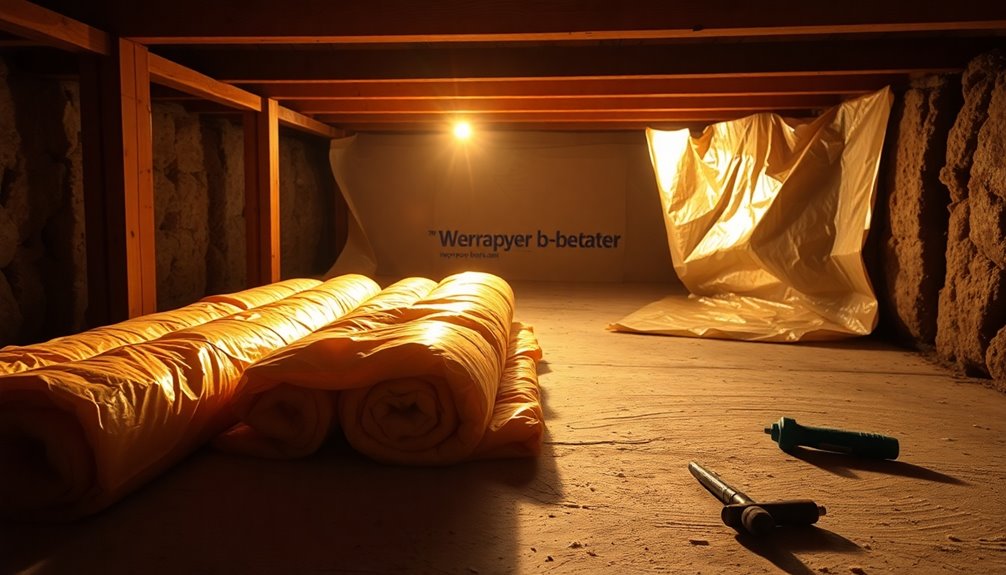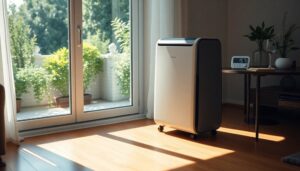To insulate your unheated crawl space affordably, start with fiberglass batts, which are budget-friendly and easy to install. Make sure to add a heavy-duty polyethylene vapor barrier to prevent moisture intrusion, sealing all seams. You can also insulate the walls to improve energy efficiency and prevent thermal bridging. Remember to seal any vents and air leaks to keep cold air out. Regularly check your insulation and vapor barrier for wear and tear. By implementing these tips, you can greatly reduce energy costs and enhance comfort. Discover more strategies to achieve ideal insulation in your space.
Understanding Unheated Crawl Spaces
When you think about the unheated crawl space beneath your home, it's important to understand its role in your overall building structure. These shallow areas provide access to plumbing and electrical systems, but they can also be a source of energy loss and moisture issues if not properly managed.
Unheated crawl spaces can be either vented or unvented, and each type requires different insulation strategies to maintain the temperature in your home. Proper insulation helps stabilize indoor temperatures, and utilizing receipt scanning technology can help you keep track of any related expenses more efficiently. Additionally, implementing budgeting and expense tracking tools can further aid in managing the costs associated with insulation projects.
Insulating a crawl space is essential for preventing cold floors above, which can lead to discomfort and increased heating costs. Proper insulation helps stabilize indoor temperatures, but it must be accompanied by effective moisture control measures.
That's where a vapor barrier comes in—this helps mitigate moisture and reduce the risk of mold growth, which can damage your home's structure.
The climate in your area plays a significant role in determining the best insulation methods for your unheated crawl spaces. Colder regions often require interior vapor barriers to prevent condensation and heat loss. Additionally, utilizing expense tracking tools can help you manage the costs associated with insulating your crawl space effectively.
Importance of Crawl Space Insulation
Understanding the importance of crawl space insulation can greatly impact your home's energy efficiency and comfort. Insulating your crawl space creates a thermal barrier that can reduce heating and cooling costs by up to 20% annually. This is especially beneficial during extreme weather conditions, as it helps maintain stable indoor temperatures, keeping those cold floors warm in winter. Additionally, monitoring savings and investments is essential for ensuring that the costs associated with insulation are justified by long-term savings. Furthermore, utilizing investment tracking tools can support informed decisions regarding home improvements such as insulation.
Moreover, proper crawl space insulation works hand-in-hand with moisture control. It prevents mold and mildew growth, which can compromise your home's structural integrity and lead to health issues related to indoor air quality. By reducing moisture, you not only protect your home but also create a healthier living environment.
Additionally, effective insulation reduces the risk of frozen pipes during cold spells, ensuring your plumbing systems remain intact. Implementing a solid insulation strategy is essential for achieving long-term financial goals, as it can significantly lower utility bills over time.
With all these benefits, homes with well-insulated crawl spaces often see an increase in property value, as energy efficiency and comfort are high priorities for prospective buyers. By prioritizing crawl space insulation, you're making a smart investment in your home's future, comfort, and overall energy performance.
Identifying Moisture Issues
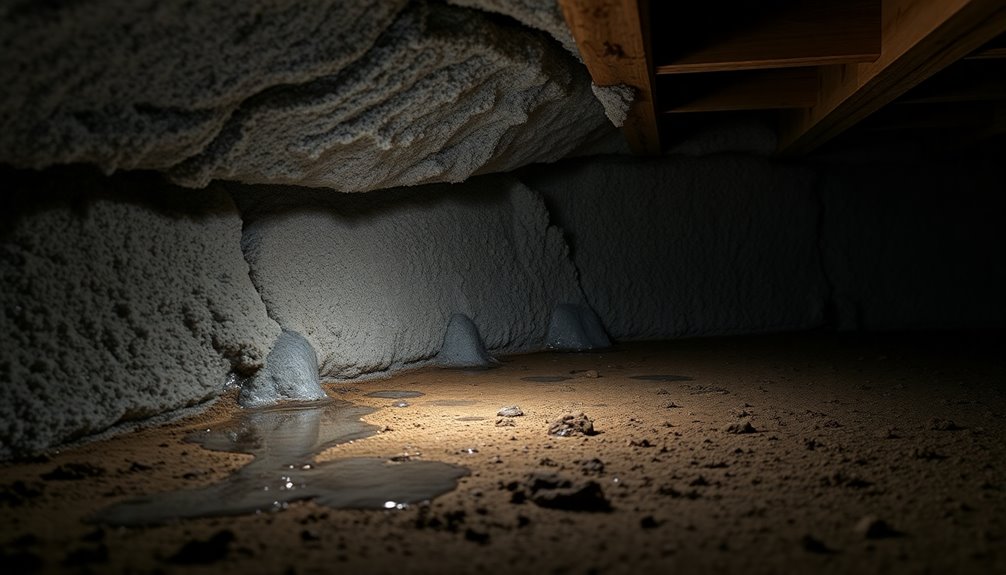
Moisture issues in crawl spaces can undermine the benefits of insulation you just invested in. To guarantee insulation effectiveness, you need to identify any sources of moist air that could lead to problems.
Start by inspecting for cracks, openings, and leaks, as these can allow moisture intrusion. High humidity levels and visible mold growth are clear indicators that you've got moisture issues that need addressing. Additionally, regular audits of your crawl space can help identify persistent moisture sources before they escalate. In addition, maintaining a proactive approach with automated payment solutions for necessary repairs can help ensure timely actions are taken when issues arise.
Regularly monitoring water levels in your crawl space is essential. Catching potential flooding or seepage early can prevent significant structural damage and costly repairs.
Proper drainage around your foundation is vital; make sure to extend downspouts and regrade soil to direct water away from the crawl space.
Installing a vapor barrier is another important step. This barrier isolates the crawl space from moisture in the ground, helping to prevent mold growth, wood rot, and structural damage. Additionally, choosing sustainable packaging solutions for any materials used can further enhance your home's eco-friendliness.
Without it, you risk compromising not only your insulation but also the overall health of your home. By addressing these moisture issues proactively, you can enjoy the full benefits of your insulation investment.
Selecting Cost-Effective Insulation Materials
When selecting insulation materials for your crawl space, it's important to compare options based on cost and effectiveness. You'll find budget-friendly choices like fiberglass batts and reflective insulation can meet your needs without breaking the bank. However, consider the long-term savings of higher-quality materials like rigid foam or spray foam, as they may offer better performance over time. Additionally, opting for user-friendly interfaces can help simplify the budgeting process for your insulation project. Implementing accurate categorization of your expenses will ensure you make informed decisions on material investments. Utilizing financial reporting tools can also aid in monitoring your spending effectively.
Insulation Material Comparison
Choosing the right insulation material for your crawl space can make a significant difference in both comfort and energy costs.
When considering insulation material comparison, fiberglass insulation stands out as a cost-effective option, typically priced between $0.50 and $1.00 per square foot. Its R-value efficiency ranges from 2.8 to 3.9 per inch, which is decent but not the highest.
If you're looking for superior thermal performance, consider spray foam insulation, which offers an impressive R-value of 5.5 to 7.1 per inch. While it requires a higher initial investment, the long-term savings on energy bills can justify the cost.
On the other hand, rigid foam board insulation, while slightly pricier at $1.50 to $2.00 per square foot, excels in moisture resistance, helping to prevent mold issues in your crawl space.
For areas with extreme heat, don't overlook reflective barriers, which can reflect up to 97% of radiant heat.
Ultimately, weighing these options based on R-value efficiency and moisture resistance will help you make an informed decision that balances upfront costs with potential long-term savings.
Budget-Friendly Options
Finding budget-friendly insulation options for your crawl space can greatly enhance your home's energy efficiency without breaking the bank. One of the most popular choices is fiberglass insulation, which is cost-effective and ideal for dry areas. With an R-value ranging from 2.8 to 3.9, it helps combat air leaks and improve insulation for crawl spaces.
If you're concerned about moisture damage, consider rigid foam board. Though slightly pricier, it offers an R-value of 3.5 to 4.2 and is moisture-resistant, providing long-term savings on energy costs.
For a more robust solution, spray foam insulation, while initially more expensive, delivers superior air sealing with an impressive R-value of 5.5 to 7.1.
You might also explore cellulose insulation, an eco-friendly option that's relatively inexpensive but requires professional installation for best results.
Finally, if you live in a hot climate, reflective or radiant barriers can be a low-cost addition to your existing insulation, helping to reduce cooling costs by reflecting heat away.
Installing a Vapor Barrier
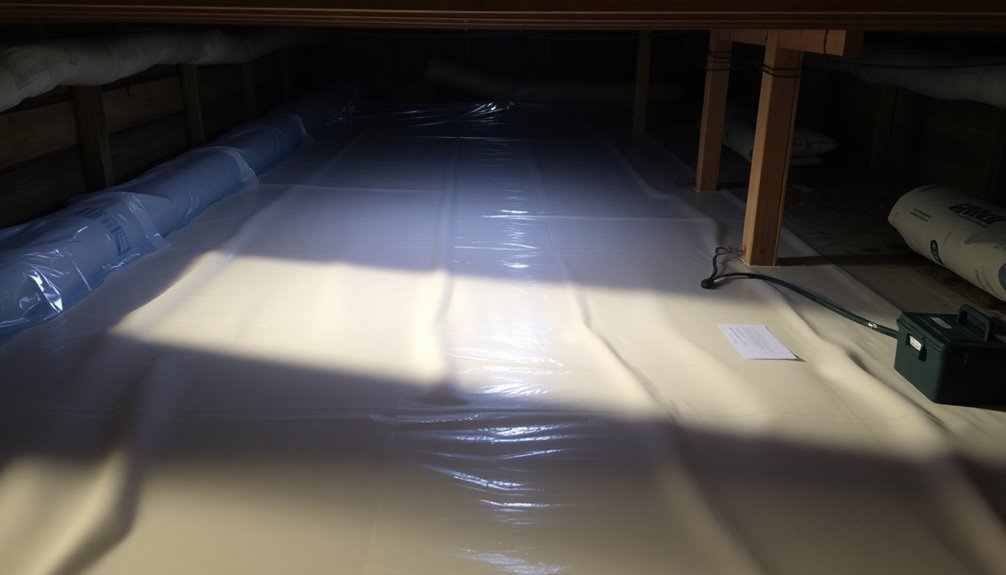
Installing a vapor barrier is essential for protecting your crawl space from moisture that can lead to mold and structural damage. Budget apps can assist you in tracking expenses related to home improvement projects, ensuring you stay within your financial limits.
To guarantee maximum effectiveness, use a heavy-duty polyethylene barrier and follow proper installation practices, like overlapping seams and sealing them well. Additionally, consider utilizing digital coupons to save on materials needed for the installation. Furthermore, taking advantage of cashback programs can also help you save more on your overall spending.
Regularly check for any damage to keep your space dry and safe.
Importance of Vapor Barrier
A vapor barrier is important for protecting your crawl space from moisture that can lead to mold growth and structural damage. By installing a heavy-duty polyethylene vapor barrier, you can greatly reduce moisture levels in your crawl space.
This not only helps maintain better indoor air quality but also minimizes the risk of wood rot in joists, which can compromise your home's structural integrity.
A well-installed vapor barrier contributes to energy efficiency by preventing cold drafts from seeping into your home. By doing so, you can effectively reduce heating costs associated with unconditioned crawl spaces.
It's essential that the vapor barrier is properly sealed, with all seams taped and extending up the walls to create a complete moisture barrier. This minimizes potential leaks and guarantees maximum effectiveness.
Regular inspections of your vapor barrier are important; any tears or punctures can allow moisture intrusion, leading to mold growth and related issues.
Installation Best Practices
Properly installing a vapor barrier is essential for safeguarding your crawl space from moisture issues. This step is critical in achieving effective crawl space encapsulation, which helps to control humidity and reduce energy costs.
Follow these best practices for a successful installation:
- Choose the Right Material: Use heavy-duty polyethylene that's at least 6 mils thick. This thickness effectively prevents moisture from the ground from entering your crawl space.
- Overlap and Seal: Overlap seams by at least 12 inches and seal them with waterproof tape. This creates a continuous barrier that enhances moisture control.
- Extend Up the Walls: Make sure to extend the vapor barrier up the walls at least 12 inches above ground level. Secure it with adhesive or mechanical fasteners to further protect against moisture intrusion.
- Inspect Regularly: Regular maintenance is important; inspect the vapor barrier for tears or punctures.
Promptly repair any damage to maintain its effectiveness and guarantee your insulation installation remains intact.
Insulating Crawl Space Walls
Insulating crawl space walls is essential for maximizing your home's energy efficiency. By insulating the walls instead of the ceilings, you can effectively prevent thermal bridging and reduce energy loss, resulting in better heating and cooling throughout your home.
For this task, foam board insulation, like SilverGlo, is your best option due to its moisture resistance and high R-value, typically ranging from 3.5 to 4.2 per inch. Unlike fiberglass batts, foam board won't sag over time, ensuring lasting effectiveness.
Proper installation is important when insulating crawl space walls. Make sure to seal all gaps and create a continuous barrier to block air and moisture infiltration.
Additionally, don't forget to install a vapor barrier on the ground. This step is essential for isolating moisture and protecting your insulation from dampness, further enhancing its longevity and efficiency.
Sealing Vents and Air Leaks
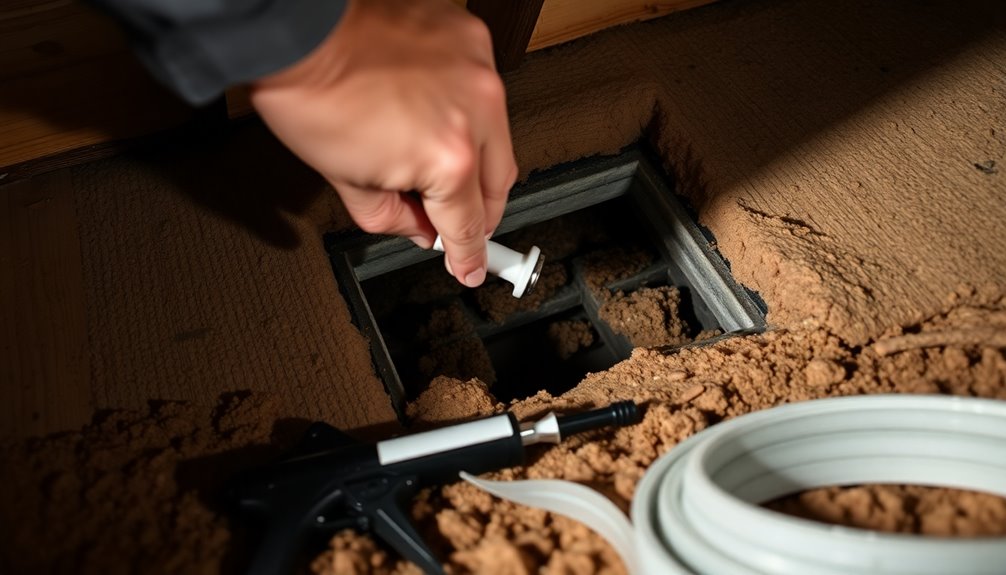
Sealing vents in your crawl space is essential for maintaining a comfortable home environment.
By using vent covers or insulated panels, you can effectively block cold air and reduce moisture issues.
This not only improves insulation performance but also offers long-term benefits like lower energy bills and a healthier living space.
Importance of Sealing Vents
The effectiveness of your home's energy efficiency hinges greatly on the condition of your crawl space vents. Moist outside air can enter through unsealed vents, leading to condensation and mold growth. This not only compromises your indoor air quality but also exacerbates temperature fluctuations, driving up your energy bills.
Here's why sealing vents is essential:
- Prevents Moisture Issues: Properly sealing vents keeps moisture from outside at bay, enhancing moisture control in your crawl space.
- Reduces Air Leaks: Using vent covers or rigid foam board considerably decreases air leaks, resulting in fewer drafts and improved energy efficiency.
- Enhances Comfort: By minimizing temperature fluctuations, you create a more stable indoor environment that keeps your living areas comfortable.
- Saves on Energy Bills: With proper sealing of rim joists and application of foam sealant for gaps, you'll notice a reduction in heating and cooling costs.
Regular inspection and maintenance of sealed vents guarantee their continued effectiveness.
Materials for Air Sealing
Achieving ideal energy efficiency in your home starts with the right materials for air sealing. One of the first steps is sealing vents and air leaks in your unheated crawl space to prevent moist outside air from entering. This moisture can lead to condensation and mold growth, which you definitely want to avoid.
Install vent covers or airtight doors to block outside air entry effectively.
Use foam sealant to fill gaps and cracks around pipes, wires, and other penetrations in the foundation walls. This will help create a more secure air barrier, reducing any potential air leaks.
Additionally, consider using rigid foam insulation on rim joists. This not only enhances thermal resistance but also strengthens your overall air sealing strategy.
Regularly inspect your crawl space for any deteriorating seals or new gaps. Even small openings can greatly undermine your insulation and air sealing efforts.
Remember, air sealing should be paired with proper ventilation strategies to maintain healthy humidity levels, preventing any moisture-related issues in the crawl space.
Taking these steps will guarantee your home remains energy-efficient and comfortable.
Benefits of Airtight Spaces
One of the key benefits of creating airtight spaces in your crawl space is the significant reduction in moisture intrusion.
By sealing vents and air leaks, you help prevent mold growth and protect your home from structural damage caused by dampness. This is essential for maintaining healthy crawl space walls and overall home integrity.
Additionally, airtight spaces contribute to energy efficiency, leading to lower utility bills.
Here are some specific advantages you'll enjoy:
- Reduced Moisture: Prevents excess moisture from entering, keeping your crawl space dry and safe.
- Lower Energy Costs: You could save 10-30% on heating and cooling costs by minimizing cold air infiltration.
- Comfortable Living: With a stable temperature, your home feels more comfortable, eliminating those annoying drafts.
- Improved Indoor Air Quality: Sealing gaps keeps outside air from entering, enhancing the air you breathe indoors.
Maintenance and Inspection Tips
Regular maintenance and inspection of your crawl space insulation is essential for guaranteeing its effectiveness and longevity. Start by regularly inspecting the insulation for any signs of damage or moisture.
Remember, fiberglass insulation can absorb water, which not only diminishes its effectiveness but can also lead to increased energy costs and potential mold growth.
Make it a point to check vapor barriers for any tears or punctures; these can allow moisture to seep into the crawl space, compromising both insulation for your crawl and overall air quality.
Confirm that your ventilation systems are functioning properly, as inadequate ventilation can lead to moisture buildup and reduce insulation performance over time.
Scheduling professional inspections every few years is a wise move. These assessments can help you maintain compliance with local building codes and maximize the energy efficiency of your crawl space.
Additionally, document any moisture issues and the solutions you've implemented prior to insulation installation. This documentation can help identify recurring problems and facilitate effective long-term solutions, confirming your crawl space remains a healthy, energy-efficient part of your home.
Professional Installation Benefits
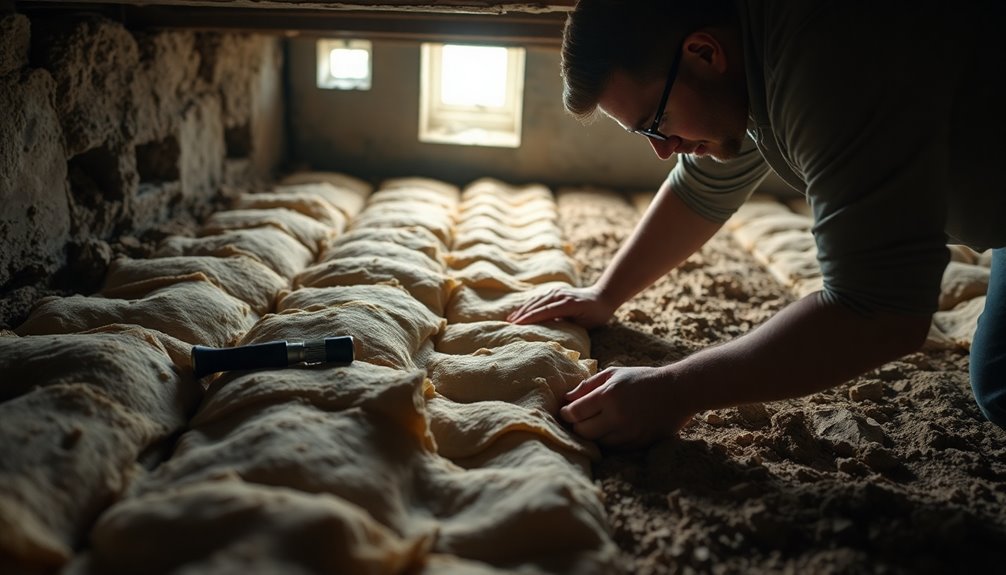
When you opt for professional installation of your crawl space insulation, you're guaranteeing that it's applied effectively and uniformly, which minimizes gaps that can lead to energy loss.
This approach maximizes the insulation's R-value performance, enhancing your home's energy efficiency. Here are some key benefits of choosing professionals for this task:
- Expertise and Tools: Professionals have specialized tools and the experience to navigate complex crawl space configurations, guaranteeing proper application of insulation materials like spray foam or rigid foam board for peak moisture resistance.
- Customized Solutions: They tailor strategies to your specific needs, considering factors like local climate and moisture levels to provide the best insulation solution for your crawl space.
- Warranties and Peace of Mind: Many insulation professionals offer warranties on their work, giving you confidence in the longevity and effectiveness of your insulation choices.
- Post-Installation Inspections: Professionals conduct inspections to identify potential issues and guarantee compliance with local building codes, enhancing your home's overall value and safety.
Energy Efficiency Gains
Choosing professional installation not only guarantees proper application but also lays the groundwork for substantial energy efficiency gains in your home. Insulating your crawl space effectively can reduce energy costs by 15-25%, minimizing heat loss and enhancing overall thermal efficiency.
By opting to insulate the crawl space walls rather than the ceilings, you'll considerably lower the chances of cold air entering your living areas, which helps maintain a comfortable indoor temperature.
Using advanced materials like spray foam insulation can provide superior performance, with an R-value of 5.5 to 7.1 per inch compared to traditional fiberglass batts. This increased insulation capacity helps make sure your crawl space remains insulated, leading to approximately 10-20% lower heating and cooling demands throughout the year.
Incorporating a vapor barrier alongside proper insulation is crucial; it not only boosts energy efficiency but also helps reduce moisture.
This combination contributes to better indoor air quality and further energy savings by minimizing the need for dehumidification. By focusing on these strategies, you're setting the stage for a more energy-efficient home that's both comfortable and cost-effective.
Local Building Codes Considerations
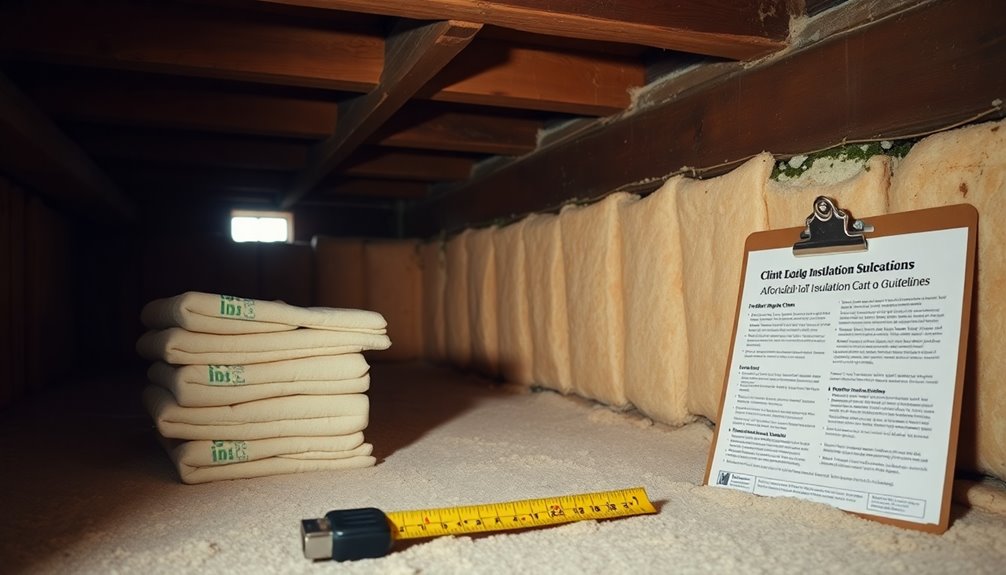
Understanding local building codes is vital for successful crawl space insulation projects. These regulations dictate how you should insulate your crawl space to guarantee safety and efficiency. Ignoring them can lead to complications, so here's what you need to know:
- Minimum R-Values: Check the minimum R-values required for your climate zone. This will guide your choice of insulation materials and thickness.
- Moisture Management: Compliance with codes guarantees effective moisture management, preventing mold growth and structural damage. Proper installation is essential.
- Ventilation Requirements: Some codes specify ventilation requirements for crawl spaces. Decide between vented or unvented insulation based on local regulations.
- Fire-Resistant Insulation: In areas where electrical wiring is present or the space is used for storage, local building codes may mandate fire-resistant insulation materials.
Conclusion
In wrapping up your crawl space insulation project, think of it as tucking your home into a warm blanket. By addressing moisture, choosing the right materials, and ensuring proper installation, you're not just saving money—you're creating a cozy haven beneath your home. So, roll up your sleeves and plunge in; your house will thank you with lower energy bills and a healthier environment. Remember, a little effort now means a big comfort boost down the road!

